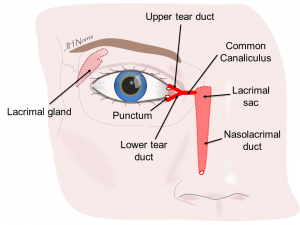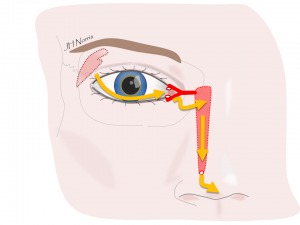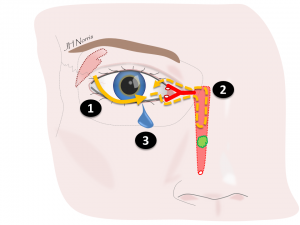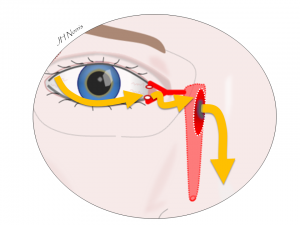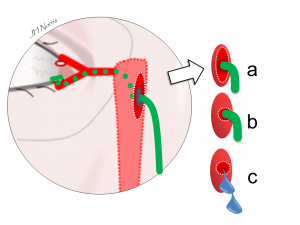Occasionally if the tears cannot drain in to the nose they become infected. This is very similar to getting a smelly kitchen drain if there is a problem with the plumbing. Dacryocystitis will manifest as a swollen, tender red lump between the nose and the lower eyelid.
The standard treatment for nasolacrimal duct obstruction (NLDO) is a dacryocystorhinostomy (DCR) procedure. This effectively bypasses the blockage in the tear duct by making a small hole in the bone on the side of your nose. The tears can then drain into the lacrimal sac (1) and into the nose via newly fashioned pathway (2) (tap to enlarge image).
This surgery can be performed either through a small incision on the side of the nose (external approach) or by using specialised endoscopes via the nose (endoscopic approach). Mr Norris will discuss with you the best method for you in clinic .
We use stents (a) to make sure the tunnel we create at the time of DCR surgery will stay open (b) and will not close up as a result of scar tissue. The idea of removing the stents at 6 weeks is that a patent passage way will be left behind for your tears to drain (c). The tears canthen drain through the new channel into the nose (tap to enlarge image).
On the day of surgery you will be asked to come into the hospital to undergo surgery. The surgery is performed usually under a general anaesthetic. If you are coming to stay the night you will need to bring some overnight clothes and toiletries for the duration of you stay. We advise that you also bring in your medications with you when you come into hospital.
Normally you are admitted for one night after DCR surgery. This is to monitor you for the initial postoperative period and allows you time to recover from the general anaesthetic. You may have some bleeding from the nose in the early stages after you surgery and we will manage this for you.
The risks of surgery include postoperative bleeding, scarring and infection. Nosebleeds are quite common after the surgery and we will monitor this. Rarely, we may need to pack the nose if the bleeding is significant.
The serious risks of the surgery are very rare. There have been reported cases of a CSF (cerebro-spinal fluid) leaks from where we make the hole in the bone and also injury to the eye.
The day after surgery you may have some bruising around the eye and some mild ooze from the nose. We would normally aim for you to be discharged on the first day after your sugery.
You are advised not to blow your nose for two weeks after your surgery and to refrain from hot beverages for at least 48 hours after you surgery to prevent against further nose bleeds. You should avoid any strenuous activity including lifting heavy objects for a least a week and avoid swimming for three weeks after surgery.
We would aim to remove your stitches at 1-2 weeks. The silicone stent that sits in the nose is usually removed at 4-6 weeks after surgery.
We will give you some oral antibiotics, a nasal spray and an eyedrop to use and the instructions for these will be given to you. The nursing staff will help you with administering these treatments before you leave the hospital.
Usually patients are quite anxious after having surgery near their eyes and most problems do settle with time. Problems that require immediate attention are a persistent nose bleed that won’t settle with ice compresses to the nose and a sitting up position. Other problems are a reduction in vision or pain that cannot be controlled with normal painkillers.
Please refer to the emergency contact page (under the header ‘Contact’) if you need advice.
Author: Mr Jonathan Norris FRCOphth

